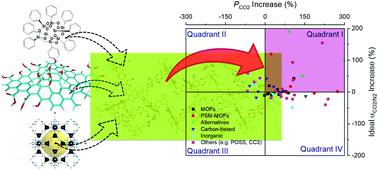Our official English website, www.x-mol.net, welcomes your feedback! (Note: you will need to create a separate account there.)
Boosting gas separation performance and suppressing the physical aging of polymers of intrinsic microporosity (PIM-1) by nanomaterial blending
Nanoscale ( IF 6.7 ) Pub Date : 2020-11-11 , DOI: 10.1039/d0nr07042d Mohd Zamidi Ahmad 1, 2, 3, 4 , Roberto Castro-Muñoz 5, 6, 7, 8 , Peter M. Budd 1, 2, 3, 4
Nanoscale ( IF 6.7 ) Pub Date : 2020-11-11 , DOI: 10.1039/d0nr07042d Mohd Zamidi Ahmad 1, 2, 3, 4 , Roberto Castro-Muñoz 5, 6, 7, 8 , Peter M. Budd 1, 2, 3, 4
Affiliation

|
In recent decades, polymers of intrinsic microporosity (PIMs), especially the firstly introduced PIM-1, have been actively explored for various membrane-based separation purposes and widely recognized as the next generation membrane materials of choice for gas separation due to their ultra-permeable characteristics. Unfortunately, the polymers suffer substantially the negative impacts of physical aging, a phenomenon that is primarily noticeable in high free volume polymers. The phenomenon occurs at the molecular level, which leads to changes in the physical properties, and consequently the separation performance and membrane durability. This review discusses the strategies that have been employed to manage the physical aging issue, with a focus on the approach of blending with nanomaterials to give mixed matrix membranes. A detailed discussion is provided on the types of materials used, their inherent properties, the effects on gas separation performance, and their benefits in the suppression of the aging problem.
中文翻译:

通过纳米材料共混提高气体分离性能并抑制固有微孔性聚合物(PIM-1)的物理老化
近几十年来,出于各种基于膜的分离目的,已经积极探索了具有固有微孔性(PIM)的聚合物,尤其是首次引入的PIM-1,由于其超高的分离度而被广泛认为是下一代气体分离的膜材料。渗透性。不幸的是,聚合物基本上遭受物理老化的负面影响,这种现象主要在高自由体积聚合物中显着。该现象在分子水平上发生,这导致物理性质的变化,并因此导致分离性能和膜耐久性的变化。这篇综述讨论了用于解决物理老化问题的策略,重点是与纳米材料混合以产生混合基质膜的方法。
更新日期:2020-11-19
中文翻译:

通过纳米材料共混提高气体分离性能并抑制固有微孔性聚合物(PIM-1)的物理老化
近几十年来,出于各种基于膜的分离目的,已经积极探索了具有固有微孔性(PIM)的聚合物,尤其是首次引入的PIM-1,由于其超高的分离度而被广泛认为是下一代气体分离的膜材料。渗透性。不幸的是,聚合物基本上遭受物理老化的负面影响,这种现象主要在高自由体积聚合物中显着。该现象在分子水平上发生,这导致物理性质的变化,并因此导致分离性能和膜耐久性的变化。这篇综述讨论了用于解决物理老化问题的策略,重点是与纳米材料混合以产生混合基质膜的方法。



























 京公网安备 11010802027423号
京公网安备 11010802027423号